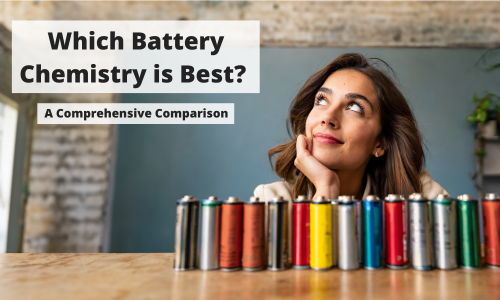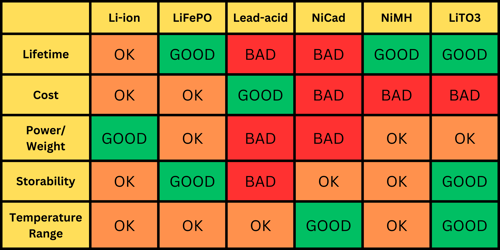Which Battery Chemistry is Best: A Comprehensive Comparison

Originally Published 3-29-2019
Batteries are everywhere.
They’re in a seemingly endless number of devices we use, from cell phones, remotes, Bluetooth speakers, golf carts and the growing category of LSEVs.
While batteries are nothing new, advancements and the race for the “best battery chemistry” is as ferocious as ever.
While the competition is intriguing, it might operate on a flawed premise.
What if there didn’t have to be a winner-take-all end to this race?
What if specific battery chemistries excel in some areas and are poor in others?
In today’s post, we answer those questions by comparing six common battery chemistries’ lifetime, cost, power/weight ratio, temperature range, storability and ease of disposal.
Take this blog post with you!
The batteries we will cover include Lithium-ion, Lithium-iron phosphate, Lithium-titanate-oxide, Lead-acid, Nickel-cadmium, and Nickel-metal hydride.
Before we dive in, here are a few notes regarding our analysis:
*Cost/Wh is based on wholesale pricing.
*Calculations are general and based on widely available information.
*Battery lifetime can vary based on the environment and the depth of discharge.
*All battery chemistries can experience potential hazards.
Lithium-ion (Li-ion)
Lifetime: 600-1,000 cycles. Integrated safety circuits limit overcharging and undercharging to protect the battery and maximize its lifetime.
Cost: $0.20/Wh
Power/Weight: 0.209Wh/gram (cylindrical cell) 0.130-0.150Wh/gram (foil pouch)
Temperature Range: 0°C to 45°C
Storability: Loses 1-2% charge/month
Disposal: Not hazardous and designed to be recycled.
Advantages
- Power/Weight
- Lifetime
- Manufacturing accessibility
Disadvantages
- Cost
- Charge circuitry is more complex and expensive
- Safety in the event of mechanical damage to the battery or charge circuitry (could result in a fire)
- Heavily regulated shipping
Ideal Use Case
- Portable electronics
Lithium-iron phosphate (LiFePO)
Lifetime: 2,000+ cycles. Integrated safety circuits limit overcharging and undercharging to protect the battery and maximize its lifetime.
Cost: $0.20/Wh
Power/Weight: 0.106Wh/g (cylindrical) 0.111Wh/g (foil pouch)
Storability: Loses 0.3% charge/month
Temperature Range: –20°C to 60°C
Disposal: Not hazardous and designed to be recycled.
Advantages
- Lifetime
- Safety
- Temperature range
- Power/Weight
Disadvantages
- Heavily regulated shipping and cost
Ideal Use Case
- Smaller stationary applications like a weather station
- Portable electronics for extreme environments.
Lithium-titanate-oxide (LiTiO3)
Lifetime: 7,000+ cycles. Integrated safety circuits limit overcharging and undercharging to protect the battery and maximize its lifetime.
Cost: $0.70/Wh
Power/Weight: 0.070Wh/g (prismatic)
Storability: Loses 0.3% charge/month
Temperature Range: -40°C to 50°C
Disposal: Not hazardous and designed to be recycled.
Advantages
- Lifetime
- Safety (safest lithium battery technology)
- Temperature range
- High current charge(5C) and discharge(10C)
Disadvantages
- Heavily regulated shipping
- Cost
- Lower power density
Ideal Use Case
- Applications where multiple charge and discharge cycles happen per day.
- Applications where high current charge and discharge rates are needed.
Lead-acid
Lifetime: 1,000-2,000 cycles (depending on the depth of discharge).
Cost: $0.08-$0.12/Wh
Power/Weight: 0.041Wh/g (cylindrical cell)
Storability: Loses 5-20% charge/month
Temperature Range: –20°C to 50°C
Disposal: Hazardous but designed to be recycled.
Advantages
- Basic charge circuitry
- Cost
- Few shipping regulations
Disadvantages
- Power/Weight
- Hazardous material
Ideal Use Case
- Large stationary applications, such as boat lift motors, electric fences and large sensor/communication arrays.
Nickel-cadmium (NiCad)
Lifetime: 1,000 cycles. Optimum performance when fully charged and fully discharged each cycle. To ensure a long lifetime, unlike many other chemistries, it’s essential to store these batteries fully discharged.
Cost: $0.40/Wh
Power/Weight: 0.057Wh/g (cylindrical)
Storability: Loses 10-15% charge/month
Temperature Range: -40°C to 70°C
Disposal: Hazardous but designed to be recycled.
Advantages
- Ultra-low resistance for high discharge rates (important in specific applications such as battery backup systems and radio-controlled electronics).
Disadvantages
- Hazardous material
- Charging (memory effect)
- Complex and expensive charge circuitry
- Heavily regulated shipping
- Cost
Ideal Use Case
- This chemistry is mostly deprecated but occasionally used in high-draw applications such as RC vehicles or camera flashes.
Nickel-metal hydride (NiMH)
Lifetime: 2,000 cycles. Standard NiMH batteries have a very high self-discharge and must be charged frequently. Eneloop-style NiMH batteries have a very low self-discharge. To achieve optimum performance, fully charge the battery each time and never fully discharge, stopping discharge once the battery reaches 20%.
Cost: $0.40/Wh
Power/Weight: 0.088Wh/g (cylindrical)
Storability: Standard loses 10-15% charge/month. Eneloop loses less than 1% charge/month.
Temperature Range: 0°C to 45°C
Disposal: Not hazardous and designed to be recycled.
Advantages
- Eneloops are a great rechargeable option for anything requiring AA, AAA or 9V batteries compared to alkaline and have a long lifetime (low self-discharge).
Disadvantages
- Expensive charge circuitry
- Heavily regulated shipping
- Cost
Ideal Use Case
- Small stationary applications (low self-discharge) such as door locks.
Choosing the best battery can be overwhelming. We can help.
With so many options available in the market, making the right decision can be challenging. Don't worry. We've got you covered!
Check out the graphic and list of winners below for a quick and easy rundown of the most critical factors you should consider when comparing batteries.

Table 1: Summary of Battery Chemistries
Battery Category Winners
Lifetime
- Lithium-iron phosphate
- Nickel-metal hydride
- Lithium-titanate-oxide
Cost
- Lead-acid
Power/Weight Ratio
- Lithium-ion
Storability
- Lithium-iron-phosphate
- Lithium-titanate-oxide
Temperature Range
- Nickel-cadmium
- Lithium-titanate-oxide
Overall
- Lithium-titanate-oxide
Batteries are crucial components of a total power solution.
Understanding how each technology compares helps determine what chemistries work best in which applications.
In the end, there isn’t a perfect battery chemistry.
What’s most important is understanding your application and utilizing the best battery chemistry for you.
At PowerFilm, we understand the importance of knowing your application inside and out to determine the best battery chemistry for you. That's why we work closely with you throughout our custom design process to ensure you have the battery chemistry that meets your needs.
Are you interested in learning more about our custom solution capabilities?
Contact us, and let’s start a conversation today.
Take this blog post with you!
Sources:
https://lithium-titanate-battery.com/lto-battery-wider-charge-discharge-temperature/
https://www.google.com/url?q=https://www.sciencedirect.com/topics/engineering/nickel-cadmium-battery